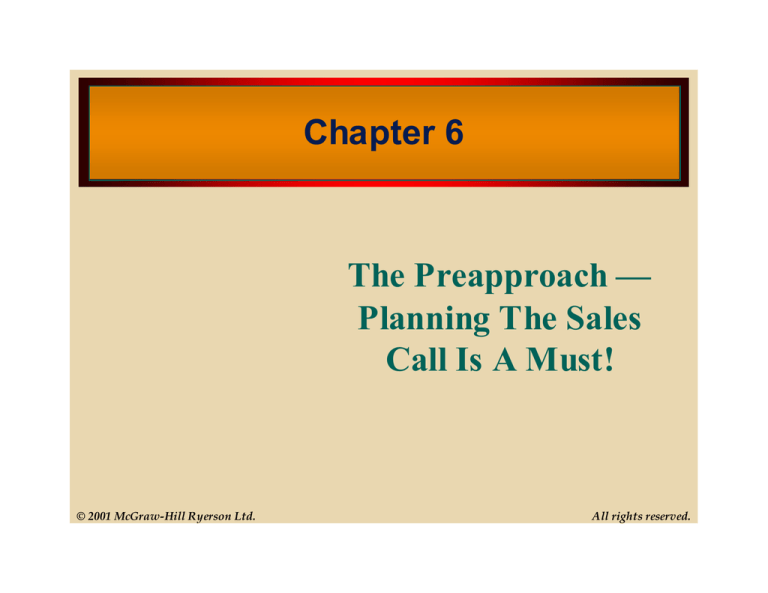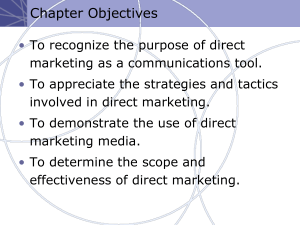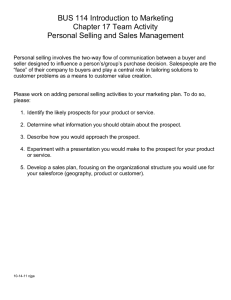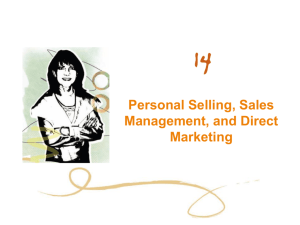
Chapter 6
The Preapproach —
Planning The Sales
Call Is A Must!
© 2001 McGraw-Hill Ryerson Ltd.
All rights reserved.
6-1
The Consultative Selling—
Customer Relationship Model
Customer
Customer
strategic
strategic
needs
needs
Performance
Performance
Goals
Goals
Mutual
Mutual
beneficial
beneficial
agreements
agreements
Salesperson’s
Salesperson’s
creative
creative
solutions
solutions
© 2001 McGraw-Hill Ryerson Ltd.
•Costs
•Costs
Long-term
Long-term
relationships
relationships
•Productivity
•Productivity
•Sales
•Sales
•Profits
•Profits
All rights reserved.
6-2
Steps in the Preapproach:
Planning the Sale
Determine
Determine
sales
salescall
call
objective
objective
© 2001 McGraw-Hill Ryerson Ltd.
Develop
Develop
customer
customer
profile
profile
Develop
Develop
customer
customer
benefits
benefits
Develop
Develop
sales
sales
presentation
presentation
All rights reserved.
6-3
Information Used in Profile and
Planning
Customer Profile and Planning Sheet
1. Name:
Address:
2. Type of business:
Name of buyer:
3. People who influence buying decision or aid in using or selling our product:
4.
5.
6.
7.
8.
9.
Buying hours and best time to see buyer:
Receptionist’s name:
Buyer’s profile:
Buyer’s personality style:
Sales call objectives:
What are customer’s important buying needs:
© 2001 McGraw-Hill Ryerson Ltd.
All rights reserved.
6-4
Information Used in Profile and
Planning
10. Sales presentation:
a. Sales approach:
b. Features, advantages, benefits:
c. Method of demonstrating FAB:
d. How to relate benefits to customer’s needs:
e. Trial close to use:
f. Anticipated objections:
g. Trial close to use:
h. How to close this customer:
i. Hard or soft close:
11. Sales made—product use/promotional plan agreed on:
12. Post sales call comments (reason did/did not buy; what to do on next call;
follow-up promised):
© 2001 McGraw-Hill Ryerson Ltd.
All rights reserved.
6-5
Examples of Topics Contained in the
Marketing Plan Segment of a Sales
Presentation
Resellers
! Advertising
" Geographical
# National
# Regional
# Local
# Co-op
" Type
# Television
# Radio
# Direct-mail
# Internet
© 2001 McGraw-Hill Ryerson Ltd.
! Sales Promotion
" Contests
" Coupons
" Demonstrations
" Samples
" Sweepstakes
" POP displays
!
!
Sales force
" Working with
their salespeople
Trade Shows
All rights reserved.
6-6
Examples of Topics Contained in the
Marketing Plan Segment of a Sales
Presentation
End-Users
! Availability
! Delivery
! Guarantee
! Installation
" Who does it?
" When?
" How?
! Maintenance/service
! Training on use
! Warranty
© 2001 McGraw-Hill Ryerson Ltd.
All rights reserved.
6-7
Examples of Topics Contained in the Business
Proposition Segment of a Sales Presentation
Resellers
! List price
! Shipping costs
! Discounts
" Cash
" Consumer
" Quantity
" Trade
" Financing
# Payment plans
# Interest rate
! Markup
! Profit
© 2001 McGraw-Hill Ryerson Ltd.
End-Users
! List price
! Shipping Costs
! Discounts
" Cash
" Quantity
! Financing
" Payment plans
" Interest rates
! ROI
! Value analysis
All rights reserved.
6-8
Major Phases in a Presentation:
A Sequence of Events to Complete in
Developing a Sales Presentation
1.1.Approach
Approach
Rapport-building
Uncover needs
Attention, interest, transition
2.2.Fully
Fullydiscuss
discuss
your
yourproduct
product
Features
Advantages
Benefits
3.3.Present
Presentyour
your
marketing
marketingplan
plan
How to resell (for reseller)
How to use (for consumers and
industrial user)
© 2001 McGraw-Hill Ryerson Ltd.
All rights reserved.
6-9
Major Phases in a Presentation:
A Sequence of Events to Complete in
Developing a Sales Presentation
4. Explain your
business proposition
What’s in it for your customers?
5. Suggested
purchase order
Recommend what to buy in order
to fill their needs uncovered in
the presentation
6. Close
Ask for the business!
7. Exit
Do not give up!
Act as a professional
Leave the door open
© 2001 McGraw-Hill Ryerson Ltd.
All rights reserved.
6-10
The Prospect’s Five Mental Steps
in Buying
Attention
Attention
Interest
Interest
© 2001 McGraw-Hill Ryerson Ltd.
Desire
Desire
Conviction
Conviction
Purchase
Purchase
All rights reserved.
6-11
The Selling Process and Examples
of Prospect’s Thoughts and Questions
Steps in the
Selling Process
Prospect’s
Mental Steps
Prospect’s Potential
Verbal and Mental
Questions
1. Prospecting
Salesperson locates
and qualifies prospects
2. Preapproach
Salesperson
determines sales call
objective, develops customer profile, customer
benefit program, and
selling strategies.
Customer’s needs
are determined.
© 2001 McGraw-Hill Ryerson Ltd.
All rights reserved.
6-12
The Selling Process and Examples
of Prospect’s Thoughts and Questions
Steps in the
Selling Process
3. Approach
Salesperson obtains
interview, meets
prospect, and begins
individualized sales
presentation.
Needs are further
uncovered.
© 2001 McGraw-Hill Ryerson Ltd.
Prospect’s
Mental Steps
Attention due to arousal of
potential need or problem.
Interest due to recognized
need or problem and the
desire to fulfill the need or
solve the problem.
Prospect’s Potential
Verbal and Mental
Questions
Should I see salesperson?
Should I continue to listen,
interact, devote much time
to a salesperson?
What’s in it for me?
All rights reserved.
6-13
The Selling Process and Examples
of Prospect’s Thoughts and Questions
Steps in the
Selling Process
4. Presentation
Salesperson relates
product benefits to
needs, using
demonstration,
dramatizations,
visuals, and proof
statements.
© 2001 McGraw-Hill Ryerson Ltd.
Prospect’s
Mental Steps
Interest in information that
provides knowledge and
influences perceptions and
attitude.
Desire begins to develop
based on information evaluation of product features,
advantages, and benefits.
This is due to forming positive attitudes that product
may fulfill need or solve
problem. Positive attitudes
brought about by
knowledge
obtained
from presentation.
Prospect’s Potential
Verbal and Mental
Questions
Is the salesperson prepared?
Are my needs understood? Is
the seller interested in my
needs?
Should I continue to listen
and interact?
So what? (to statements
about features)
Prove it! (to statements about
advantages)
Are the benefits of this
product the best to fulfill
my needs?
All rights reserved.
6-14
The Selling Process and Examples
of Prospect’s Thoughts and Questions
Steps in the
Selling Process
Prospect’s
Mental Steps
5. Trial close
Salesperson asks
prospect’s opinion on
benefits during and
after presentation.
Desire continues based on
information evaluation.
6. Objections
Salesperson uncovers
objections.
Desire continues based on
information evaluation.
© 2001 McGraw-Hill Ryerson Ltd.
Prospect’s Potential
Verbal and Mental
Questions
Do I understand the
salesperson’s marketing
plan and business
proposition?
I need more information to
make a decision. Can you
meet my conditions?
All rights reserved.
6-15
The Selling Process and Examples
of Prospect’s Thoughts and Questions
Steps in the
Selling Process
7. Meet Objections
Salesperson
satisfactorily answers
objections.
© 2001 McGraw-Hill Ryerson Ltd.
Prospect’s
Mental Steps
Desire begins to be
transformed into belief.
Conviction established due to
belief the product and
salesperson can solve needs
or problems better than
competitive products.
Appears ready to buy.
Prospect’s Potential
Verbal and Mental
Questions
Let me see the reaction when
I give the salesperson a
hard time.
I have a minor/major
objection to what you are
saying.
Is something nonverbal being
communicated?
Did I get a reasonable answer
to my objection?
All rights reserved.
6-16
The Selling Process and Examples
of Prospect’s Thoughts and Questions
Steps in the
Selling Process
Prospect’s
Mental Steps
8. Trial Close
Salesperson uses
another trial close to
see if objections have
been overcome; or if
presentation went
smoothly before the
close, to determine
if the prospect is ready
to buy.
Conviction becomes stronger.
© 2001 McGraw-Hill Ryerson Ltd.
Prospect’s Potential
Verbal and Mental
Questions
Can I believe and trust this
person?
Should I reveal my real
concerns?
All rights reserved.
6-17
The Selling Process and Examples
of Prospect’s Thoughts and Questions
Steps in the
Selling Process
9. Close
Salesperson has
determined prospect is
ready to buy and now
asks for the order.
© 2001 McGraw-Hill Ryerson Ltd.
Prospect’s
Mental Steps
Action (purchase) occurs
based on positive beliefs
that the product will fulfill
needs or solve problems.
Prospect’s Potential
Verbal and Mental
Questions
I am asked to make a buying
decision now.
If I buy and I am dissatisfied,
what can I do?
Will I receive after-the-sale
service as promised?
What are my expectations
toward this purchase?
Why don’t you ask me to
buy?
Ask one more time and I’ll
buy.
All rights reserved.
6-18
The Selling Process and Examples
of Prospect’s Thoughts and Questions
Steps in the
Selling Process
Prospect’s
Mental Steps
10. Follow-Up
Salesperson provides
customer service after
the sale.
Satisfaction—Dissatisfaction
© 2001 McGraw-Hill Ryerson Ltd.
Prospect’s Potential
Verbal and Mental
Questions
Did the product meet my
expectations?
Am I experiencing
dissonance?
How is the service associated
with this product?
Should I buy again from this
salesperson?
All rights reserved.





